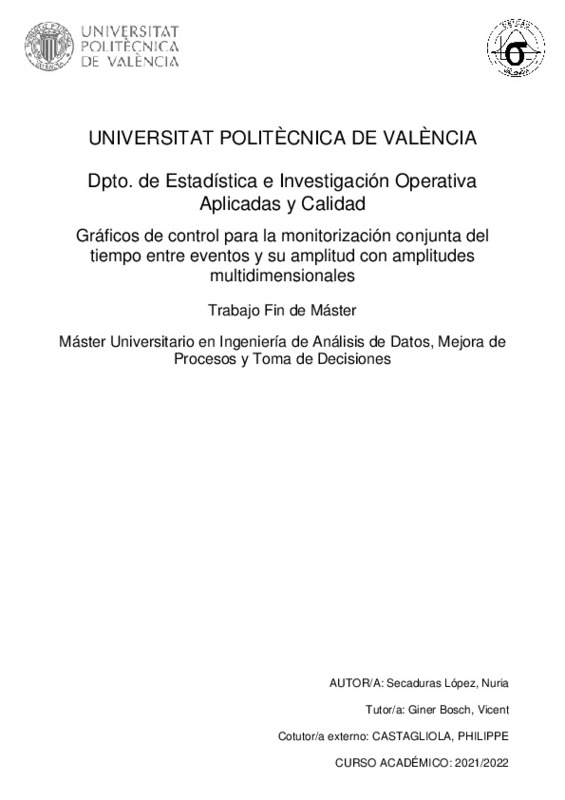|
Resumen:
|
[ES] En este trabajo, se aborda el diseño, implementación y análisis de gráficos
de control para la monitorización del tiempo entre eventos o sucesos y, al mismo
tiempo, la amplitud o tamaño de dichos eventos (lo cual ...[+]
[ES] En este trabajo, se aborda el diseño, implementación y análisis de gráficos
de control para la monitorización del tiempo entre eventos o sucesos y, al mismo
tiempo, la amplitud o tamaño de dichos eventos (lo cual se conoce en inglés como
"time between events and amplitude", TBEA). Concretamente, se estudia el caso,
inédito en la literatura, en que la amplitud tiene carácter multidimensional. Esto
puede ser de interés en muchos contextos reales (por ejemplo, medir el tiempo
entre incendios y, al mismo tiempo, su gravedad, etc.).
Se proponen tres modelos para la monitorización conjunta del tiempo y la
amplitud. Para cada uno de ellos, se obtiene de manera analítica la función de
distribución del estadístico monitorizado. A partir de esto, se diseñan gráficos de
control unilaterales para detectar el empeoramiento o degradación del fenómeno
objeto de interés (en concreto, la disminución del tiempo entre sucesos y/o incrementos
de la amplitud de dichos sucesos).
El diseño de los gráficos propuestos se implementa en lenguaje R. Posteriormente,
se realizan pruebas computacionales orientadas a valorar la aptitud de
estos gráficos para detectar diferentes situaciones de degradación o falta de control.
De esta forma, y mediante tanto técnicas de diseño de experimentos clásicas
como métodos robustos frente a las condiciones que presente la batería de pruebas
generada, se puede analizar el comportamiento de los tres modelos propuestos en
diversos escenarios.
Así, en base a los resultados obtenidos, se llega a conclusiones que permiten
conocer qué parámetros son más influyentes en el rendimiento del gráfico y cuál
de los tres enfoques planteados resulta más conveniente en función del contexto
y de los requerimientos del usuario final.
Por último, se ejemplifica la aplicación del gráfico de control diseñado mediante
la simulación de un caso práctico basado en datos reales.
[-]
[EN] In this paper, we address the design, implementation and analysis of control
charts for joint monitoring the time between events or occurrences and the
amplitude or size of these events (known as time between events ...[+]
[EN] In this paper, we address the design, implementation and analysis of control
charts for joint monitoring the time between events or occurrences and the
amplitude or size of these events (known as time between events and amplitude,
TBEA). In particular, we study the case ¿unprecedented in the literature¿
where amplitude has a multidimensional character. This may be of interest in
many real-world contexts (e.g. measuring the time between fires and, at the same
time, their severity, etc.).
We propose three models for the joint monitoring of time and amplitude.
For each of them, the distribution function of the monitored statistic is obtained
analytically. From this, one-sided control charts are designed to detect the worsening
or deterioration of the phenomenon of interest (specifically, the decrease
in the time between events and/or increases in the amplitude of these events).
The design of the proposed graphs is implemented in software R. Subsequently,
computational tests are performed to evaluate the aptitude of these graphs to
detect different situations of degradation or lack of control. In this way, and by
means of classical design of experiments techniques and robust methods that consider
the conditions presented in the battery of tests generated, the behaviour of
the three proposed models can be analysed in different scenarios.
Therefore, based on the results obtained, conclusions can be drawn as to which
parameters are most influential in the performance of the graph and which of the
three proposed approaches is most suitable depending on the context and the
requirements of the end user.
Finally, we present an example about the application of the designed control
chart by simulating a practical case based on real data.
[-]
|







